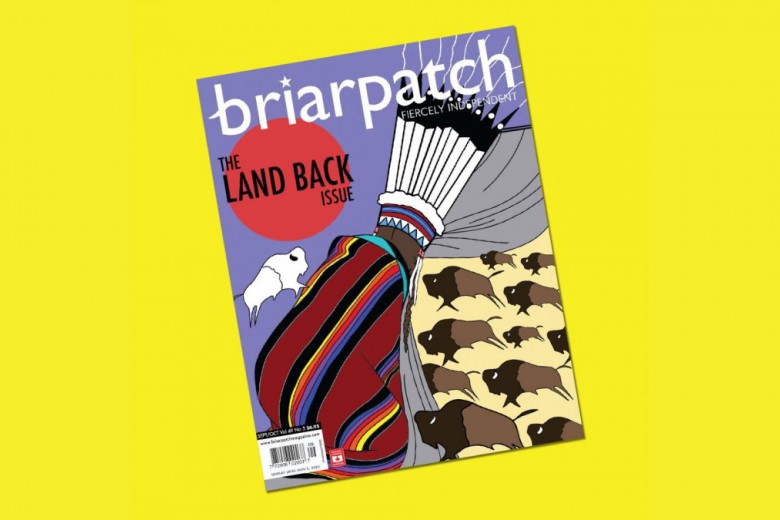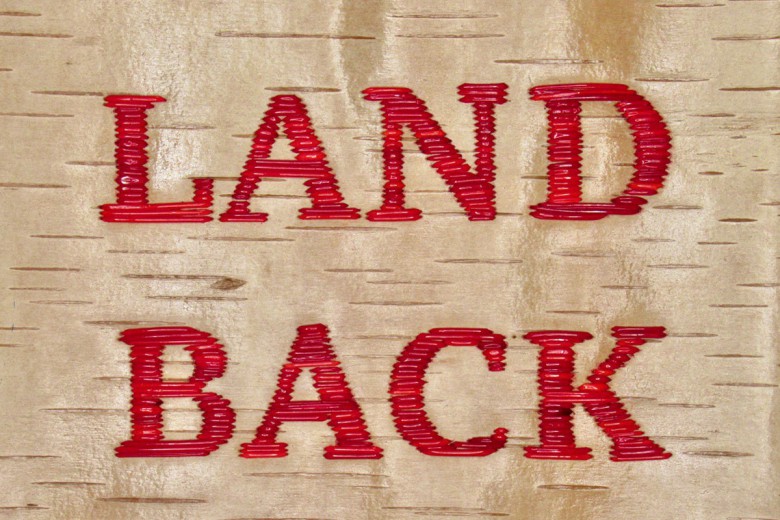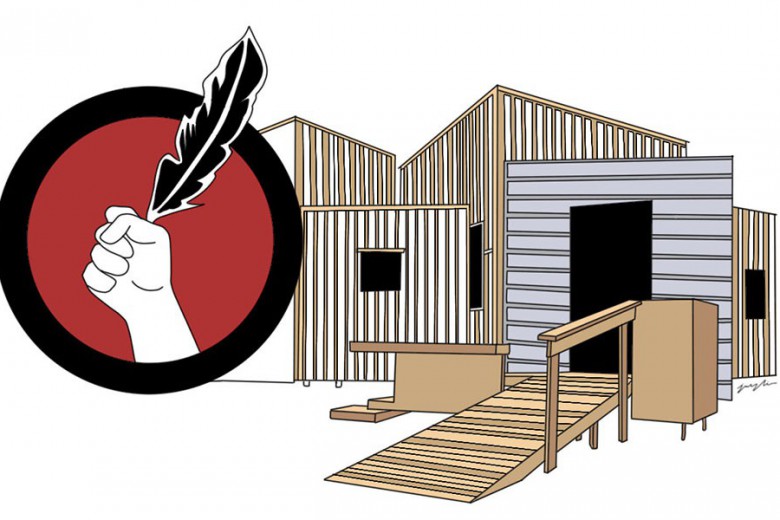Whether their traditional lands are now occupied by a metropolis, or their families left their home communities for better opportunities, or they moved off the reserve to get a degree, the story behind every Indigenous person who lives in a city is different. Since we are so often displaced from our home territories, living on territories that are not ours, agreeing on what “Land Back” looks like in cities is difficult. What an urban Inuit community needs will be different from what an urban Ojibwe community needs. These needs arise from each nation’s distinct histories and struggles under colonialism.
When there are large populations of settlers and other non-Indigenous people living in cities, along with city infrastructure like public roads, rematriating land becomes difficult. It does not seem so easy to rematriate Toronto, or the city that I live in, Guelph.
What an urban Inuit community needs will be different from what an urban Ojibwe community needs. These needs arise from each nation’s distinct histories and struggles under colonialism.
That’s not to say that municipalities can’t give land back. It’s happened – like when the city of Vancouver gave a small tract of land in the south of the city back to the Musqueam Nation. Municipal land should be given back in some way, since most (if not all) cities are breaking treaties, or are situated on land that wasn’t even ceded via treaty in the first place.
But when municipal land can’t or won’t be given back, other Indigenous-led Land Back projects spring up. From urban medicine gardens like Tkaronto’s Mashkiki gitigaanan to Tasha Spillett’s research on connecting Indigenous girls with land-based knowledge in prairie cities, Land Back is happening whether or not cities are ready for it.
Even so, our own understandings of how to decolonize and heal have been warped by colonialism, which has stripped us of our traditional knowledge. This is not to say that we are doing badly or failing at decolonization – I think these challenges are typical and should be expected. Because of colonization, all Indigenous Nations have lost some of their traditional knowledge. And even when the modern people of these nations return to their traditional knowledge, there are gaps. It’s nothing to be ashamed of. The people I trust say that the grandmothers are forgiving, and I believe they will forgive our ignorance.
To understand what Land Back could mean in cities, I interviewed my sister, Ginnifer Menominee, an Ojibwe and Potawotami Anishinaabe Bear Clan woman from Wasauksing First Nation. She is the manager of an Indigenous health-care program in Guelph. Her job is to make sure that the programming, protocol, and governance of the program is in line with Indigenous truths.
The people I trust say that the grandmothers are forgiving, and I believe they will forgive our ignorance.
This is no easy role, since there’s a wide diversity of Indigenous people in Guelph, which is an extremely colonial city. Guelph is situated on the territory of Mississaugas of the Credit, an Anishinaabe nation, on land governed by the Between the Lakes Purchase, or Treaty 3. The treaty was signed in 1792, when the settlers of British North America needed land to house an influx of Loyalists and allies from the Six Nations Confederacy who lost their homes fighting on the side of the British during the American Revolutionary War. The land was purchased from the Mississaugas with the understanding that the communities would reside peacefully alongside each other, since these were the Missisaugas’ ancestral lands and home to important river networks of trade. Rivers and lakes were never considered a part of the treaty – these are invaluable and are meant to be kept by Mississauga women. It is the Mississaugas who are the inherent rights holders and treaty holders of the land and waterways on which Guelph is situated.
When I ask her about the importance of treaties, Ginnifer explains that we must create concrete relationships with the ancestral inheritors and treaty holders of the territory on which we live. To put it simply, who claimed the land they now call Guelph before the settlers squatted?
“I've grown up with not a really deep understanding of what all the treaties were about, but I did have that understanding around the protocols that surround it,” she explains. Even Indigenous people “still need to know and understand our treaties – and if we don’t, we're actually not able to enact those Treaty Rights as spelled out within those treaties.”
It is the Mississaugas who are the inherent rights holders and treaty holders of the land and waterways on which Guelph is situated.
She talks about her relationship with Nancy Rowe, an Anishinaabekwe from the Mississaugas of the Credit. Nancy is the director of Akinomaagaye Gaamik, a traditional Anishinaabek roundhouse used for workshops and education, based out of Mississaugas of the Credit First Nation.
“That's really a vital relationship,” Ginnifer tells me. “She actually informs how I deliver programming. Often I respectfully go to her and say, ‘I would like to have youth come out and learn about building a canoe.’ Because it involves not only learning how to harvest, it involves knowing the times when you can do this, how to build it, the science and geometry. I think that is giving that inherent knowledge back to our kids.”
When I ask her what Land Back means to her, she says, simply, “I think Land Back for me would be to have the rights over our inherent territories.”
“I'm from Parry Sound, and that region belongs to us Anishinaabe people, but we're confined to this small little island, which is our reserve. In the way the treaties are enacted, the Crown took all of those lands and gave them to settlers. So Land Back for me would be some form of reciprocity where we have access to go on to our own territories; to be able to harvest, hunt, and enact our Treaty Rights. And we can't do that; we're limited to the boundaries of our reserve. While we do have animals and different vegetation on there, we can't hunt because it's such a small area. We can't enact those Treaty Rights, so it becomes very difficult for us to actually sustain ourselves in our traditional way.”
“I think that the treaties in this area, like the Dish With One Spoon as well as the treaties with the Mississaugas, really inform how I deliver programming. Without that we're disrespecting the grandchildren that might come forward, and they're not going to understand why we’re bringing culture and ceremony back.” She says that in order to be aligned with Anishinaabe governance, we need to respect the next seven generations of Mississauga children, who will be the inheritors of these lands and treaties.
Even Indigenous people “still need to know and understand our treaties – and if we don’t, we're actually not able to enact those Treaty Rights as spelled out within those treaties.”
She says that without letting treaty inform her programming, “It's like me bringing in Cherokee teachings in this territory. I mean, there might be some Cherokee people, but this is Anishinaabe territory. Why would I be teaching Cherokee teachings?”
“Nancy always has this way of saying that it's like me going into Sioux territory and saying that I want to teach your grandchildren, so I just walk into your house and I start teaching your grandchildren about Anishinaabe ways. But you're the grandmother, you want them to be taught in the way that Sioux are brought up. So the grandmother has every right over her grandchildren to say ‘No, I don't want you teaching them that way.’”
When we talk about Land Back in cities, we’re often talking about access to ceremonial land – people want a place to gather and host their ceremonies. But when people demand land from municipalities for ceremony without consulting the treaty holders, it disrespects the ceremonial jurisdiction that the treaty holders have over their territory. At the organization she works for, Ginnifer consults and involves members of the Mississaugas of the Credit when bringing back ceremony and using land in Guelph.
“I see that as, in a way, a treaty in itself,” she continues. “You're going to ask, ‘Hey, can I come into your house? Can I teach your kids some Anishinaabe teachings?’ And if that grandmother says no, you should be like, ‘Okay.’ You're not going to go back and try to sell it to her like, ‘Come on let me do it! Let me teach your grandchildren, they'll know better after this!’ I think we should always be deferring to the treaty holders.”
"Without that we're disrespecting the grandchildren that might come forward, and they're not going to understand why we’re bringing culture and ceremony back.”
I asked her specifically about what Land Back looks like in an urban center like Guelph.
“I've had a lot of time to kind of think and reflect on what something like Land Back would look like in an urban center, being that there's not much green space,” she says. “People always want the ability to do ceremony, and it is really difficult in an urban center because there's no actual green space to do it in. And you’re not necessarily going to throw down a sweat in a park.”
“We’re going through a traumatic experience of grief where we're looking for a safe space so that we can enact our rights of doing ceremony, of healing in a good way,” she continues. “We're in this traumatic grief of wanting to have territory to call our own but we've been dispossessed, we've been enfranchised, we've got intergenerational trauma from residential schools and adopted-out ’60s Scoop babies, and so we’re all in the state of trying to figure out who we are. That land is always calling to us and it's really difficult in urban space to actually get that. So when you do have a relationship like the ones that we do have with Everdale, that's magical.”
Everdale is a community teaching farm just outside of Guelph, founded in 1998. They provide hands-on food and farming programs to build and engage healthy local communities. Since 2019, the health-care program Ginnifer works for has been hosting ceremonies on the land at Everdale.
“In a way, we actually made treaty with Everdale. We brought in the pipe [ceremony] that led that day around what was going to happen on the land.” Ginnifer refers to an Anishinaabe pipe ceremony, where tobacco is smoked and prayers and intentions are put forth. “Even before we dug in and started making a deck [for a yurt to host ceremony in], we had this process of treaty-making, of coming to an understanding that we had good intentions, that we are only coming in to respect this territory. And the inherent right holder was there. So I think we got the go-ahead from the grannies – they said this space is magic and there's going to be a lot of things to come out of it.”
“In a way, we actually made treaty with Everdale."
To end our conversation, we shared ideas on what municipalities can do to make sure that urban Indigenous people face fewer barriers to accessing land: removing fees for campgrounds and conservation areas, and waiving fees for using public parks and other municipal properties; amending fire bylaws to allow Indigenous people to hold their ceremonies without having to ask the fire marshal for permission or risking fines; returning to the original Anishinaabe names for the Speed and Eramosa Rivers; ensuring that treaties are understood and openly spoken about and acknowledged. Sovereignty comes in many forms, and these are small, concrete steps toward Land Back that cities can take.
The question of “whose land is it anyways?” is one that’s often forgotten or pushed aside when making broader calls for Land Back. But treaty holders’ rights are inherent, and we should remember that we shouldn’t pan-Indigenize while trying to find solutions for ourselves in urban centers. We can demand Land Back without appropriating inherent jurisdiction, and remember the intentions of the treaties governing these lands. Through a shared understanding and recognition of these treaties, their true intentions can be enacted by both Indigenous people and settlers. The treaties will dictate Land Back, as these treaties are what our ancestors agreed upon for the shared use of this land. It is our duty to remember them, since we are all treaty people.






